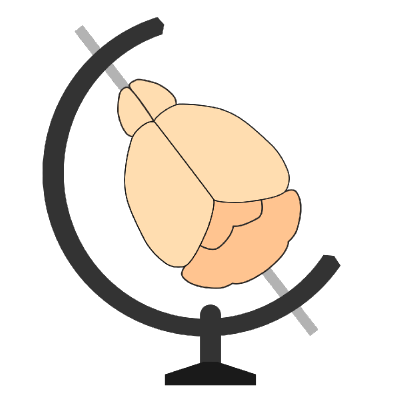cellfinder.core API#
The API is not yet fully documented. For an idea of what the parameters do, see the documentation for the napari plugin.
To run the full pipeline (cell candidate detection and classification)#
from cellfinder.core.main import main as cellfinder_run
import tifffile
signal_array = tifffile.imread("/path/to/signal_image.tif")
background_array = tifffile.imread("/path/to/background_image.tif")
voxel_sizes = [5, 2, 2] # in microns
detected_cells = cellfinder_run(signal_array,background_array,voxel_sizes)
The output is a list of brainglobe-utils Cell objects.
Each Cell has a centroid coordinate, and a type:
print(detected_cells[0])
# Cell: x: 132, y: 308, z: 10, type: 2
Cell type 2 is a “real” cell, and Cell type 1 is a “rejected” object (i.e., not classified as a cell):
from brainglobe_utils.cells.cells import Cell
print(Cell.CELL)
# 2
print(Cell.NO_CELL)
# 1
Saving the results#
If you want to save the detected cells for use in other BrainGlobe software (e.g. the napari plugin), you can save in the cellfinder XML standard:
from brainglobe_utils.IO.cells import save_cells
save_cells(detected_cells, "/path/to/cells.xml")
You can load these back with:
from brainglobe_utils.IO.cells import get_cells
cells = get_cells("/path/to/cells.xml")
Using dask for lazy loading#
cellfinder.core supports most array-like objects.
Using Dask arrays allows for lazy loading of data, allowing large (e.g. TB) datasets to be processed.
cellfinder.core comes with a function (based on napari-ndtiffs) to load a series of image files (e.g. a directory of 2D tiff files) as a Dask array.
cellfinder.core can then be used in the same way as with a numpy array.
from cellfinder.core.main import main as cellfinder_run
from brainglobe_utils.IO.image.load import read_with_dask
signal_array = read_with_dask("/path/to/signal_image_directory")
background_array = read_with_dask("/path/to/background_image_directory")
voxel_sizes = [5, 2, 2] # in microns
detected_cells = cellfinder_run(signal_array,background_array,voxel_sizes)
Running the cell candidate detection and classification separately#
import tifffile
from cellfinder.core.detect import detect
from cellfinder.core.classify import classify
from cellfinder.core.tools.prep import prep_models
from cellfinder.core.download.download import DEFAULT_DOWNLOAD_DIRECTORY
signal_array = tifffile.imread("/path/to/signal_image.tif")
background_array = tifffile.imread("/path/to/background_image.tif")
voxel_sizes = [5, 2, 2] # in microns
start_plane = 0
end_plane = -1
trained_model = None
model_weights = None
model = "resnet50_tv"
batch_size = 64
n_free_cpus = 2
network_voxel_sizes = [5, 1, 1]
soma_diameter = 16
ball_xy_size = 6
ball_z_size = 15
ball_overlap_fraction = 0.6
log_sigma_size = 0.2
n_sds_above_mean_thresh = 10
soma_spread_factor = 1.4
max_cluster_size = 100000
cube_width = 50
cube_height = 50
cube_depth = 20
network_depth = "50"
model_weights = prep_models(
model_weights,
DEFAULT_DOWNLOAD_DIRECTORY,
model,
)
cell_candidates = detect.main(
signal_array,
start_plane,
end_plane,
voxel_sizes,
soma_diameter,
max_cluster_size,
ball_xy_size,
ball_z_size,
ball_overlap_fraction,
soma_spread_factor,
n_free_cpus,
log_sigma_size,
n_sds_above_mean_thresh,
)
if len(cell_candidates) > 0: # Don't run if there's nothing to classify
classified_cells = classify.main(
cell_candidates,
signal_array,
background_array,
n_free_cpus,
voxel_sizes,
network_voxel_sizes,
batch_size,
cube_height,
cube_width,
cube_depth,
trained_model,
model_weights,
network_depth,
)
Training the network#
The training data needed are matched pairs (signal & background) of small (usually 50 x 50 x 100μm) images centred on the coordinate of candidate cells. These can be generated however you like, but we recommend the napari plugin.
cellfinder.core comes with a 50-layer ResNet trained on ~100,000 data points from serial two-photon microscopy images of mouse brains (available here).
Training the network is likely simpler using the napari plugin, but it is possible through the Python API.
from pathlib import Path
from cellfinder.core.train.train_yaml import run as run_training
# list of training YAML files
yaml_files = [Path("/path/to/training_yaml.yaml)]
# where to save the output
output_directory = Path("/path/to/saved_training_data")
run_training(
output_directory,
yaml_files,
learning_rate=0.0001,
continue_training=True, # by default use supplied model
test_fraction=0.1,
batch_size=16,
save_progress=True,
epochs=10,
)
